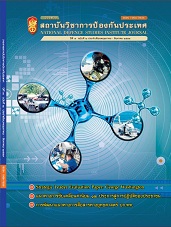แนวทางการเพิ่มประสิทธิผลการต่อต้านวัตถุระเบิดแสวงเครื่อง ของกลุ่มผู้ก่อความไม่สงบในพื้นที่จังหวัดชายแดนภาคใต้
Main Article Content
Abstract
แนวทางการเพิ่มประสิทธิผลการต่อต้านวัตถุระเบิดแสวงเครื่อง
ของกลุ่มผู้ก่อความไม่สงบในพื้นที่จังหวัดชายแดนภาคใต้
Guidelines on Enhancing the Effective of Countering IEDs
Manipulated by Insurgents in Southern Border Provinces.
บทคัดย่อ
การศึกษาวิจัยนี้มีวัตถุประสงค์เพื่อ 1) ศึกษารูปแบบการก่อความรุนแรงด้วยวัตถุระเบิดแสวงเครื่องของกลุ่มผู้ก่อความไม่สงบ 2) ศึกษาปัจจัยเอื้อที่ทำให้กลุ่มผู้ก่อความไม่สงบดำรงการก่อความรุนแรงด้วยวัตถุระเบิดแสวงเครื่องได้อย่างต่อเนื่อง 3) ศึกษาแนวทางการเพิ่มประสิทธิผลการต่อต้านวัตถุระเบิดแสวงเครื่องของกลุ่มผู้ก่อความไม่สงบ โดยใช้กระบวนการวิจัยเชิงคุณภาพ การเก็บข้อมูลแบบทุติยภูมิ ผู้วิจัยเก็บรวบรวมข้อมูลจากเอกสารรายงานหน่วยงานความมั่นคง ขอบเขตข้อมูลตั้งแต่ พ.ศ.2547 - 2558 การเก็บข้อมูลแบบปฐมภูมิ ใช้วิธีการสังเกต และการสัมภาษณ์ โดยเลือกผู้ให้ข้อมูลสำคัญ คือ เจ้าหน้าที่รัฐ และสมาชิกผู้ก่อความไม่สงบ
ผลการศึกษาพบว่า วัตถุระเบิดแสวงเครื่องของกลุ่มผู้ก่อความไม่สงบ มักมีส่วนประกอบสำคัญ 6 ส่วน ประกอบด้วย แหล่งพลังงาน สวิตช์/วงจร ตัวจุดระเบิด ภาชนะบรรจุ ดินระเบิด และส่วนสังหารเพิ่มเติม มีรูปแบบการทำงานหลัก คือ การบังคับจุด ตั้งเวลา และเหยื่อมากระทำ สามารถแบ่งตามลักษณะการใช้งานได้ 3 รูปแบบ คือ ประจำที่ ขว้าง และประกอบในยานพาหนะ โดยใช้การโจมตีต่อเป้าหมายบนท้องถนนเป็นยุทธวิธีหลัก สำหรับปัจจัยเอื้อที่ทำให้สามารถดำรงการก่อเหตุได้อย่างต่อเนื่อง มาจากปัจจัยสภาพแวดล้อมทางกายภาพและทางสังคมซึ่งส่งผลให้เกิดปัจจัยเอื้อภายในของกลุ่มขบวนการตามมา ได้แก่ กำลังพล เงินทุน อุปกรณ์ และการบริหารจัดการ ผลการศึกษาสามารถกำหนดแนวทางการต่อต้านวัตถุระเบิดแสวงเครื่อง แบ่งเป็น 3 กิจกรรมหลัก คือ การขัดขวางและจำกัดเสรี การป้องกันอันตราย และการเตรียมความพร้อม ทั้งนี้เพื่อ ให้เกิดประสิทธิผลการต่อต้านวัตถุระเบิดแสวงเครื่องที่ได้จากการวิจัยครั้งนี้ ควรศึกษาหาแนวทางการจัดหน่วยและการบริหารจัดการที่เหมาะสมกับการต่อต้านวัตถุระเบิดแสวงเครื่องในการทำวิจัยครั้งต่อไป
คำสำคัญ : การต่อต้านวัตถุระเบิดแสวงเครื่อง/ กลุ่มผู้ก่อความไม่สงบ/ จังหวัดชายแดนภาคใต้
Abstract
This research was aimed to 1) study the patterns of insurgency through the manupulation of IEDs among insurgents, 2) explore the factors advocating the continual manipulation of IEDs among insurgents, and 3) to investigate the guidelines on enhancing the effectiveness of counter-IED manipulation. Qualitative research as well as secondary data collection were conducted. The data was collected from the relevant security agencies with the scope between B.E. 2547 – B.E. 2558. The primary data was collected by observation and interviews with keynote persons like government officers and insurgents.
The results indicated that the components of insurgents’ IEDs basically included power sources, switches/circuits, detonators, containers, main charge, and additional fatal dispatchers. The main operations of IEDs were locating spots, setting time, and determining victims. The usage patterns could be divided into 3, namely, placing at exact/particular areas, throwing, and adhering to vehicles. Insurgents mostly focused on road or street attack as their core strategy. Physical as well as social factors advocated the continual manipulation of IEDs, and also led to other supporting factors within insurgent groups, i.e., personnel, funds, equipment/tools, and management. The results were employed to create the guidelines on counter-IED through the 3 essential activities, i.e, obstruction and freedom limitation; harm prevention; and preparation.
The recommendation from the research revealed an interesting issue. To clarify, for more effective of counter-IED, guidelines on unit and proper management/administration for counter-IED should be generated for future researches.
Keywords : Counter-IED / insurgents / southern border provinces
Article Details
The articles, images, tables, graphs, written content, and opinions published in this journal are solely those of the authors and do not necessarily reflect the views or positions of the National Defence Studies Institute or its academic affiliates.


